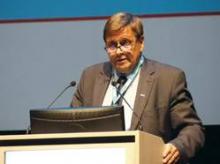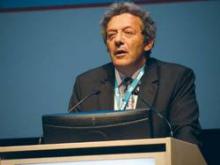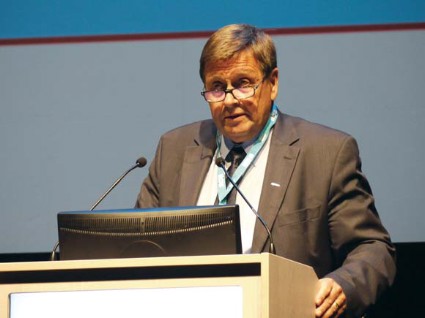User login
AMSTERDAM – Treatment with the somatostatin analogue lanreotide halves the risk for progression and death in patients with nonfunctioning neuroendocrine gastroenteropancreatic tumors, according to results from a phase III study.
Patients randomized to treatment with lanreotide (Somatuline Autogel) achieved a progression-free survival (PFS) of 66%, compared with 22% for placebo, within 96 weeks of the first injection (hazard ratio, 0.47; P = .0002), Dr. Kjell Öberg reported at the European Cancer Congress 2013. This outcome represents a 53% reduction in the risk for progression and death, he said.
"The previous restrictions on the use of somatostatin analogues in nonfunctioning tumors are no longer justified," said Dr. Öberg, professor of endocrine oncology at University Hospital Uppsala in Sweden.
Gastroenteropancreatic neuroendocrine tumors (GEP-NETs) are those that are not associated with any hormone-related symptoms. It was previously thought that somatostatin analogues were only of benefit to patients with NETs that did produce hormones and had no antiproliferative effects per se. However, this study "has clearly sorted that out," said Dr. Öberg, the invited discussant for the trial, at the multidisciplinary European cancer congresses. "I think that guidelines will be changed within the next year in many countries."
The new findings from CLARINET (Placebo-Controlled Study of Lanreotide Antiproliferative Response in Patients with GEP-NET) build on those of a smaller (n = 85) prospective trial, PROMID. The results of the PROMID study showed that another somatostatin analogue, octreotide (Sandostatin LAR), increased PFS in patients with metastatic midgut NETs – 66.7% vs. 37.2% for placebo – with a median PFS of 14.3 months vs. 6 months (HR, 0.34; P = .00007) (J. Clin. Oncol. 2009;27:4656-63). The most favorable effects seen in that trial were in patients with a low hepatic tumor load and where the primary tumor had been resected.
CLARINET was a much larger, multicenter, randomized, double blind, placebo-controlled trial involving 204 patients with nonfunctioning GEP-NETs. A total of 101 patients were randomized to lanreotide at an intramuscular dose of 120 mg every 28 days, and 102 patients were randomized to a matching placebo.
The mean age of recruited patients was 63 years in the lanreotide arm and 62 years in the placebo arm. Just over half the participants in each group were male. The majority of patients in the lanreotide and placebo groups had tumors involving the pancreas (42% and 48%, respectively) and midgut (33% and 39%), with the hindgut involved in 11% and 3% of cases in each group. Almost all (96%) of those recruited had stable disease (Ki67 less than 10%), and 81% were treatment naive. One-third had a hepatic tumor load of more than 25%.
"Median PFS was not reached with lanreotide; it was 18 months with placebo [P = .0002]," study investigator Dr. Philippe Ruszniewski of the Hôpital Beaujon in Clichy, France, reported.
The effect of active treatment as compared to placebo appeared very pronounced in patients with NETs involving the midgut (HR, 0.35; P = .009), although a significant benefit was seen in patients with pancreatic tumors (HR, 0.58; P = .064). There was also a significant benefit seen regardless of tumor grade (HR, 0.43; P = .0016 for G1; and HR, 0.45; P = .0235 for G2) and hepatic tumor load.
"Patients with a limited hepatic tumor load, below 25%, experienced a significant improvement in PFS [HR, 0.34; P = .0002]," Dr. Ruszniewski noted. Those with higher hepatic tumor loads, above 25%, also showed a significant PFS benefit (HR, 0.45; P = .017). Median PFS was not reached in either subgroup treated with lanreotide, while it was 9 months in the limited tumor load and 24 months in the higher tumor load groups that received placebo.
There was no difference in overall survival, however, with 19 deaths reported in the lanreotide arm and 17 deaths in the placebo arm (P = .879).
"Safety and tolerability were expected," Dr. Ruszniewski observed. There were 89 and 93 treatment-emergent adverse effects in the lanreotide and placebo groups, respectively. Of these, 50% and 28% were related to the interventions. Three percent of each group withdrew due to treatment-emergent adverse events.
The most common (10% of patients) side effects seen in the lanreotide and placebo arms were diarrhea (26% vs. 9%, respectively), abdominal pain (14% vs. 2%), and cholelithiasis (10% vs. 3%).
The proportion of patients achieving a 50% or greater reduction in chromogranin A levels from baseline – an indicator of an antiproliferative effect – was significantly higher in the lanreotide arm than in the placebo arm (odds ratio, 15.2; P less than .0001).
"The antiproliferative effect of lanreotide may support its place in the treatment algorithm for enteropancreatic NETs," Dr. Ruszniewski said.
In an interview, Dr. Öberg further commented that the CLARINET data show that "somatostatin analogues can be used for patients with all different subtypes of NET with a very low rate of side effects." If more aggressive therapy is needed, he added, then targeted treatment with drugs such as everolimus or chemotherapy may be needed. "The guidelines will change," he reiterated.
The study was sponsored by Ipsen. Dr. Ruszniewski has served as an adviser to Ipsen and received research funding from the company and from Novartis. Dr. Öberg has served as an adviser and speaker for Novartis, Ipsen, and Pfizer.
AMSTERDAM – Treatment with the somatostatin analogue lanreotide halves the risk for progression and death in patients with nonfunctioning neuroendocrine gastroenteropancreatic tumors, according to results from a phase III study.
Patients randomized to treatment with lanreotide (Somatuline Autogel) achieved a progression-free survival (PFS) of 66%, compared with 22% for placebo, within 96 weeks of the first injection (hazard ratio, 0.47; P = .0002), Dr. Kjell Öberg reported at the European Cancer Congress 2013. This outcome represents a 53% reduction in the risk for progression and death, he said.
"The previous restrictions on the use of somatostatin analogues in nonfunctioning tumors are no longer justified," said Dr. Öberg, professor of endocrine oncology at University Hospital Uppsala in Sweden.
Gastroenteropancreatic neuroendocrine tumors (GEP-NETs) are those that are not associated with any hormone-related symptoms. It was previously thought that somatostatin analogues were only of benefit to patients with NETs that did produce hormones and had no antiproliferative effects per se. However, this study "has clearly sorted that out," said Dr. Öberg, the invited discussant for the trial, at the multidisciplinary European cancer congresses. "I think that guidelines will be changed within the next year in many countries."
The new findings from CLARINET (Placebo-Controlled Study of Lanreotide Antiproliferative Response in Patients with GEP-NET) build on those of a smaller (n = 85) prospective trial, PROMID. The results of the PROMID study showed that another somatostatin analogue, octreotide (Sandostatin LAR), increased PFS in patients with metastatic midgut NETs – 66.7% vs. 37.2% for placebo – with a median PFS of 14.3 months vs. 6 months (HR, 0.34; P = .00007) (J. Clin. Oncol. 2009;27:4656-63). The most favorable effects seen in that trial were in patients with a low hepatic tumor load and where the primary tumor had been resected.
CLARINET was a much larger, multicenter, randomized, double blind, placebo-controlled trial involving 204 patients with nonfunctioning GEP-NETs. A total of 101 patients were randomized to lanreotide at an intramuscular dose of 120 mg every 28 days, and 102 patients were randomized to a matching placebo.
The mean age of recruited patients was 63 years in the lanreotide arm and 62 years in the placebo arm. Just over half the participants in each group were male. The majority of patients in the lanreotide and placebo groups had tumors involving the pancreas (42% and 48%, respectively) and midgut (33% and 39%), with the hindgut involved in 11% and 3% of cases in each group. Almost all (96%) of those recruited had stable disease (Ki67 less than 10%), and 81% were treatment naive. One-third had a hepatic tumor load of more than 25%.
"Median PFS was not reached with lanreotide; it was 18 months with placebo [P = .0002]," study investigator Dr. Philippe Ruszniewski of the Hôpital Beaujon in Clichy, France, reported.
The effect of active treatment as compared to placebo appeared very pronounced in patients with NETs involving the midgut (HR, 0.35; P = .009), although a significant benefit was seen in patients with pancreatic tumors (HR, 0.58; P = .064). There was also a significant benefit seen regardless of tumor grade (HR, 0.43; P = .0016 for G1; and HR, 0.45; P = .0235 for G2) and hepatic tumor load.
"Patients with a limited hepatic tumor load, below 25%, experienced a significant improvement in PFS [HR, 0.34; P = .0002]," Dr. Ruszniewski noted. Those with higher hepatic tumor loads, above 25%, also showed a significant PFS benefit (HR, 0.45; P = .017). Median PFS was not reached in either subgroup treated with lanreotide, while it was 9 months in the limited tumor load and 24 months in the higher tumor load groups that received placebo.
There was no difference in overall survival, however, with 19 deaths reported in the lanreotide arm and 17 deaths in the placebo arm (P = .879).
"Safety and tolerability were expected," Dr. Ruszniewski observed. There were 89 and 93 treatment-emergent adverse effects in the lanreotide and placebo groups, respectively. Of these, 50% and 28% were related to the interventions. Three percent of each group withdrew due to treatment-emergent adverse events.
The most common (10% of patients) side effects seen in the lanreotide and placebo arms were diarrhea (26% vs. 9%, respectively), abdominal pain (14% vs. 2%), and cholelithiasis (10% vs. 3%).
The proportion of patients achieving a 50% or greater reduction in chromogranin A levels from baseline – an indicator of an antiproliferative effect – was significantly higher in the lanreotide arm than in the placebo arm (odds ratio, 15.2; P less than .0001).
"The antiproliferative effect of lanreotide may support its place in the treatment algorithm for enteropancreatic NETs," Dr. Ruszniewski said.
In an interview, Dr. Öberg further commented that the CLARINET data show that "somatostatin analogues can be used for patients with all different subtypes of NET with a very low rate of side effects." If more aggressive therapy is needed, he added, then targeted treatment with drugs such as everolimus or chemotherapy may be needed. "The guidelines will change," he reiterated.
The study was sponsored by Ipsen. Dr. Ruszniewski has served as an adviser to Ipsen and received research funding from the company and from Novartis. Dr. Öberg has served as an adviser and speaker for Novartis, Ipsen, and Pfizer.
AMSTERDAM – Treatment with the somatostatin analogue lanreotide halves the risk for progression and death in patients with nonfunctioning neuroendocrine gastroenteropancreatic tumors, according to results from a phase III study.
Patients randomized to treatment with lanreotide (Somatuline Autogel) achieved a progression-free survival (PFS) of 66%, compared with 22% for placebo, within 96 weeks of the first injection (hazard ratio, 0.47; P = .0002), Dr. Kjell Öberg reported at the European Cancer Congress 2013. This outcome represents a 53% reduction in the risk for progression and death, he said.
"The previous restrictions on the use of somatostatin analogues in nonfunctioning tumors are no longer justified," said Dr. Öberg, professor of endocrine oncology at University Hospital Uppsala in Sweden.
Gastroenteropancreatic neuroendocrine tumors (GEP-NETs) are those that are not associated with any hormone-related symptoms. It was previously thought that somatostatin analogues were only of benefit to patients with NETs that did produce hormones and had no antiproliferative effects per se. However, this study "has clearly sorted that out," said Dr. Öberg, the invited discussant for the trial, at the multidisciplinary European cancer congresses. "I think that guidelines will be changed within the next year in many countries."
The new findings from CLARINET (Placebo-Controlled Study of Lanreotide Antiproliferative Response in Patients with GEP-NET) build on those of a smaller (n = 85) prospective trial, PROMID. The results of the PROMID study showed that another somatostatin analogue, octreotide (Sandostatin LAR), increased PFS in patients with metastatic midgut NETs – 66.7% vs. 37.2% for placebo – with a median PFS of 14.3 months vs. 6 months (HR, 0.34; P = .00007) (J. Clin. Oncol. 2009;27:4656-63). The most favorable effects seen in that trial were in patients with a low hepatic tumor load and where the primary tumor had been resected.
CLARINET was a much larger, multicenter, randomized, double blind, placebo-controlled trial involving 204 patients with nonfunctioning GEP-NETs. A total of 101 patients were randomized to lanreotide at an intramuscular dose of 120 mg every 28 days, and 102 patients were randomized to a matching placebo.
The mean age of recruited patients was 63 years in the lanreotide arm and 62 years in the placebo arm. Just over half the participants in each group were male. The majority of patients in the lanreotide and placebo groups had tumors involving the pancreas (42% and 48%, respectively) and midgut (33% and 39%), with the hindgut involved in 11% and 3% of cases in each group. Almost all (96%) of those recruited had stable disease (Ki67 less than 10%), and 81% were treatment naive. One-third had a hepatic tumor load of more than 25%.
"Median PFS was not reached with lanreotide; it was 18 months with placebo [P = .0002]," study investigator Dr. Philippe Ruszniewski of the Hôpital Beaujon in Clichy, France, reported.
The effect of active treatment as compared to placebo appeared very pronounced in patients with NETs involving the midgut (HR, 0.35; P = .009), although a significant benefit was seen in patients with pancreatic tumors (HR, 0.58; P = .064). There was also a significant benefit seen regardless of tumor grade (HR, 0.43; P = .0016 for G1; and HR, 0.45; P = .0235 for G2) and hepatic tumor load.
"Patients with a limited hepatic tumor load, below 25%, experienced a significant improvement in PFS [HR, 0.34; P = .0002]," Dr. Ruszniewski noted. Those with higher hepatic tumor loads, above 25%, also showed a significant PFS benefit (HR, 0.45; P = .017). Median PFS was not reached in either subgroup treated with lanreotide, while it was 9 months in the limited tumor load and 24 months in the higher tumor load groups that received placebo.
There was no difference in overall survival, however, with 19 deaths reported in the lanreotide arm and 17 deaths in the placebo arm (P = .879).
"Safety and tolerability were expected," Dr. Ruszniewski observed. There were 89 and 93 treatment-emergent adverse effects in the lanreotide and placebo groups, respectively. Of these, 50% and 28% were related to the interventions. Three percent of each group withdrew due to treatment-emergent adverse events.
The most common (10% of patients) side effects seen in the lanreotide and placebo arms were diarrhea (26% vs. 9%, respectively), abdominal pain (14% vs. 2%), and cholelithiasis (10% vs. 3%).
The proportion of patients achieving a 50% or greater reduction in chromogranin A levels from baseline – an indicator of an antiproliferative effect – was significantly higher in the lanreotide arm than in the placebo arm (odds ratio, 15.2; P less than .0001).
"The antiproliferative effect of lanreotide may support its place in the treatment algorithm for enteropancreatic NETs," Dr. Ruszniewski said.
In an interview, Dr. Öberg further commented that the CLARINET data show that "somatostatin analogues can be used for patients with all different subtypes of NET with a very low rate of side effects." If more aggressive therapy is needed, he added, then targeted treatment with drugs such as everolimus or chemotherapy may be needed. "The guidelines will change," he reiterated.
The study was sponsored by Ipsen. Dr. Ruszniewski has served as an adviser to Ipsen and received research funding from the company and from Novartis. Dr. Öberg has served as an adviser and speaker for Novartis, Ipsen, and Pfizer.
AT THE EUROPEAN CANCER CONGRESS 2013
Major finding: Progression-free survival was 66% in the group treated with the somatostatin analogue, compared with 22% in the placebo group (HR, 0.47; P = .0002).
Data source: Phase III CLARINET study, a multicenter, randomized, double-blind, placebo-controlled trial evaluating lanreotide’s efficacy and safety in 204 patients with well or moderately differentiated, nonfunctioning gastroenteropancreatic neuroendocrine tumors.
Disclosures: The study was sponsored by Ipsen. Dr. Ruszniewski has served as an adviser to Ipsen and received research funding from the company and from Novartis. Dr. Öberg has served as an adviser and speaker for Novartis, Ipsen, and Pfizer.


